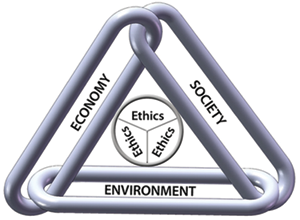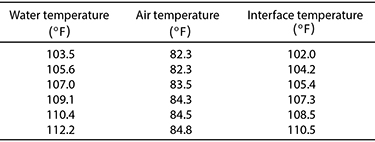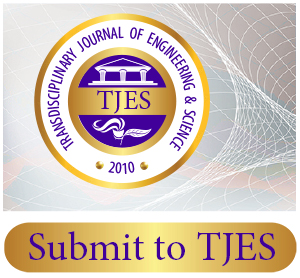| Information |
|---|
| For Readers |
| For Authors |
| For Librarians |
Author guidelines
Instructions for Authors
Manuscripts submitted to Transdisciplinary Journal of Engineering & Science (TJES) must not be under simultaneous consideration by any other publisher and should not have been published elsewhere in substantially similar form. Electronic PDF or Word files of the manuscripts should be submitted by one of the authors of the manuscript through the online TJES Manuscript Tracking System. The submitting author takes responsibility for the paper during submission and peer review.
Submission Checklist
- Please Read the Aims & Scope to gain an overview and assess if your manuscript is suitable for this journal;
- IMPORTANT: Manuscripts that do not contribute to transdisciplinary research will be deemed outside the scope of this journal. The manuscript should include a section that thoroughly describes the transdisciplinary research process. Additionally, the manuscript must articulate its relation to previously published papers in the Journal of Transdisciplinary Engineering & Science.
- Make sure that issues about publication ethics, copyright, authorship, figure formats, data, and references format have been appropriately considered;
- Ensure that all authors have approved the content of the submitted manuscript.
Shortcut links
Manuscript Submission
Editorial Policies
Research and Publication Ethics
Manuscript Preparation
Peer Review
Reviewers Recommendation
Authorship
Preparing Figures and Tables
Reference Style
1. Manuscript Submission
1.1 Types of Publications
TJES doesn’t have any restrictions on the length of manuscripts, provided that the text is concise and comprehensive. Complete experimental details should be provided so that the results can be reproduced. The main article types are as follows:
- Articles: TJES considers all the original research manuscripts provided that the work reports scientifically sound experiments and provides a substantial amount of new information.
- Reviews: TJES also considers work to provide concise and precise updates on the latest progress made in a given area of research.
1.2 Submission Process
Manuscripts for TJES should be submitted online at www.atlas-tjes.org. To submit your manuscript, register and log in to the TJES website. Once you have logged in, electronic Word files of the manuscripts should be submitted by the responsible author of the manuscript through the online TJES Manuscript Tracking System. The submitting author takes responsibility for the paper during submission and peer review.
1.3 Terms of Submission
Manuscripts submitted to TJES should neither be published before nor be under consideration for publication in another journal. The submitting author must ensure that all eligible co-authors have been included in the author list and that they have all read and approved the submitted version of the manuscript. It is also the submitting author’s responsibility to ensure that the article has all necessary institutional approvals. Only an acknowledgment from the editorial office formally confirms the date of receipt. Other communication and proofs will be sent to the author(s) before publication unless otherwise indicated. All requests about the publication of accepted manuscripts should be addressed to tjes@atlas-tjes.org
1.4 Accepted File Formats
This system supports the submission of the manuscript in Word and Latex and figures in TIFF, JPEG, PDF, and Windows Metafile (always use a minimum of 300 dpi). Complete files must not exceed 100 MB. If this is a concern, please contact the editorial office tjes@atlas-tjes.org. Accepted file formats are:
- Microsoft Word: use your manuscripts in Microsoft Word using this template file. Please include your graphics (schemes, figures, etc.) in the main text after the paragraph of its first citation. Manuscripts must be converted into a single file before submission.
- LaTeX: Manuscripts prepared in LaTeX must be assembled into one ZIP folder (please include all source files and images). Preparing your manuscripts in LaTeX use this LaTeX template files.
- Accepted papers will be properly re-formatted using LaTex by the ATLAS publishing department for publication.
1.5 Cover Letter
A cover letter must be included with each manuscript submission. It should be brief and give reasons for why the content of the paper is significant and it fits the scope of this journal. In other words, papers submitted to this journal must be in accord with the articles published in this journal. State that neither the manuscript nor any parts of its content are currently under consideration or published in another journal.
2. Editorial policies
All manuscripts are subject to peer review and are anticipated to meet standards of academic excellence. After an initial review by the editor to make sure that the manuscript meets minimum editorial standards and fits within the scope of the journal, submissions will be considered by peer-reviewers, whose identities will remain anonymous to the authors. Decisions to reject are at the discretion of the Editor.
The Editor or members of the Journal Editorial Board may sometimes submit their manuscripts for possible publication in the TJES. In these situations, the peer review process will be handled by other members of the Board and the submitting Editor / Board member will have no involvement in the decision-making process.
All participating authors who have made a considerable contribution (such as substantial contributions to the conception, design, analysis, or interpretation of data for the work, drafting or revising the work, etc.) to the article should be listed as authors. Leading authorship and order of the authorship should be based on the relative scientific contributions of the participating authors involved. Changes to the author list should be approved by all authors including any who have been removed from the list.
2.3 Acknowledgements
All contributors who do not meet the criteria for authorship should be listed in an Acknowledgements section.
2.4 Funding Statement
Authors are required to acknowledge how the research and publication of their article was funded under a separate heading. For example: "This work was supported by the National Science Foundation [grant number zzzz]." If the research did not receive specific funding authors should state that: This research received no specific grant from any funding agency in the public, commercial, or not-for-profit sectors.
2.5 Declaration of conflicting interests
Authors will include a declaration of any conflicting interest under the heading 'Conflicts of Interest.' If no declaration is made, under this heading, statement of ‘None declared’ will be printed. Otherwise, authors may wish to state that ‘The Author(s) declare(s) that there is no conflict of interest’. Leading authors are responsible for coauthors declaring their interests.
Authors can recommend potential reviewers. Before contacting those reviewers, journal editors will check to make sure there are no conflict of interests. Authors can also enter the names of potential reviewers they want to exclude from consideration in the review of their manuscript at the time of the initial submission progress.
In order to maintain the integrity, transparency and reproducibility of research, authors are encouraged to share their experimental and research data openly available either by depositing into a suitable public repositories or by publishing the data and files as supplementary information in this journal.
2.8 Supplementary Material
Additional data and files can be submitted as "Supplementary Materials" during the manuscript submission process. The supplementary files will also be available to the referees as part of the peer-review process.
3. Research and Publication Ethics
3.1 Research Ethics
3.1.1 Research Involving Human Subjects
If the research involves human subjects, human material, human tissues, or human data, authors must declare that the investigations were carried out following the rules of the Declaration of Helsinki of 1975 (https://www.wma.net/what-we-do/medical-ethics/declaration-of-helsinki/). A statement including the project identification code, date of approval, and name of the institutional review board (or ethic committee) should be cited in the Methods Section of the article. If research involves human subjects, authors are encouraged to get advice from institutional review board or ethic committee.
3.1.2 Research Involving Cell Lines
If the research involves with cell lines authors should state the origin of any cell lines. For created cell lines the source should be stated and references must be given to either a published paper or to a commercial source. If the gifted from another laboratory unpublished de novo cell lines were used, details of institutional review board or ethics committee approval must be provided.
3.2 Publishing Ethics
TJES policy does not allow authors to submit the same manuscript for possible consideration by another journal and does not allow publication of a manuscript that has been published in whole or in part by another journal.
3.2.1 Plagiarism Screening
Plagiarism includes copying text, ideas, images, or data from another source, even from your own publications, without giving any credit to the original source. All manuscripts are subject to plagiarism screening by SmallSE Tools' Plagiarism Checker. Software is used to detect instances of overlapping and similar text in submitted manuscripts. If plagiarism is detected during the peer review process, the manuscript may be rejected.
4. Manuscript Preparation
An example of a research article manuscript template can be downloaded here. We recommend that all manuscripts follow the structure below:
4.1 Title and Authorship Information
The following information should be included for all authors listed on the paper:
- The title of the manuscript (must be explicit and include no more than ten words).
- Full author names including affiliations
- Full institutional mailing addresses
- Email addresses and phone numbers
4.2 Abstract
A short self-contained, citation-free abstract of no more than 150 words must be included on the first page.
4.3 Keywords
Four or more relevant keywords need to be added after the abstract. We recommend that the keywords are specific to the research subject, such as: Transdiscipline, convergence, collective impact, sustainability, and environment.
4.4 Introduction
This section should be brief and should highlight why it is important, preferably with no subheadings. It should define the object of the work and its importance. The current state of the art related to research field should be reviewed thoroughly and key publications cited. Finally, briefly mention the main goal of the work and highlight the major conclusions.
4.5 Methodology
Authors should explain with satisfactory detail to make available others to replicate and build on published results. New methods and protocols should be explained in detail while other established methods will be briefly described and properly cited.
4.6 Results
Authors should provide a brief and specific description of the experimental results, their interpretation as well as the experimental conclusions that can be obtained.
4.7 Discussion
Authors should discuss the results and how they can be translated in view of previous studies. The results and their implications should be discussed in dept as much as possible. Limitations of the work should also be highlighted.
4.8 Conclusions
Brief discussions of the findings should be provided in this section. In some cases, discussion and conclusion can be combined under one section.
4.9 Author Contribution
How the participating authors contributed for this research will be included in this section. Please ignore this section if there is only one author.
4.10 Funding Statement
Authors should state how the research and publication of their article was funded, by naming financially supporting bodies followed by any associated grant numbers in square brackets.
4.11 Conflicts of Interest
Authors must clearly state any personal circumstances or interest that may be identified as inappropriately affecting the representation or explanation of reported research results.
4.12 Acknowledgments
Indicate grants that you have received in support of your research work in this section. Also, contributors who do not meet the criteria for authorship should be listed in this section.
4.13 Supplementary Materials
Explain any supplementary material provided online together with the manuscript (figure, tables, video, spreadsheets, etc.).
4.14 Patents
May be added if there are patents resulting from the work reported in this section. But it is not mandatory.
5. Preparing Figures and Tables
5.1 Preparation of Figures
All figures should be included in the manuscript. They should not be submitted in separate files. If the paper is accepted, authors will be asked to provide the source files of the figures. Each figure should be supplied in a separate electronic file. All figures should be cited in the paper in consecutive order. Figures should be a minimum of 300 dpi JPG or PDF.

Figure 1: Sustainability and interconnectivity of environment, economy, and society.
5.2 Preparation of Tables
All tables should be included in the manuscript. All tables should be cited in the paper in consecutive order. All tables should be numbered consecutively and have a caption consisting of the table number and a brief title. This number should be used when referring to the table in the text. Font size should be a minimum of 6 pt. See the below table as an example.
Table 1: Experimental results for interface temperature.

6. Math Formulae
Math formulae are printed using Greek symbols. Equations must be edited with Equation Editor or MathType. Equations should be centered and numbered consecutively beginning with (1) to the end of the paper. The number should be enclosed in parentheses (as shown below) and set flush right on the same line as the equation. It is this number that should be used when referring to equations within the text. Equations should be referenced within the text as Eq. (1).
Z=X + y (1)
7. Reference Style
APA Format Citation Guide (Revised January 1, 2025)
Starting January 1, 2025, this journal will be using the following APA journal article citation style.
Format Examples: APA reference list in alphabetical order.
In-Text Citation (Paraphrase):
Author (Last Name, Year) … Such as (Brown, 2012)
In-Text Citation (Quotation):
(Author Surname [of Chapter or Article], Year, page number) … Such as (Brown, 2012, p.270)
References:
Author (Last Name), (First Name). (Middle Name). (Publication Year). Article Title. Periodical Title, Volume (Issue), pp-pp.
Examples:
For Journal Articles
Mann, B. P. (2007). Experimental study of an impact oscillator. International Journal of Nonlinear Mechanics, 50(2), 587-596.
For Books
Brown, A., (1993). The Engineering Design Process. Wiley & Sons.
For Edited Books
Miller, J., & Smith, T. (Eds.), (1996). Cape Cod stories: Tales from Cape Cod (pp. 112-119). ATLAS Publishing.
For Chapter in an Edited Books
Jones. K. (2021). Sunset of tales. In Miller, J., & Smith, T. (Eds.), (1996). Cape Cod stories: Tales from Cape Cod. ATLAS Publishing.
For Proceedings
Smith, R., (1999). Probabilistic design of offshore structures under wave forces. In Collis, M.& Munro, L. (Eds.), Design for uncertainty. Paper presented at the Integrated Design and Process Science Conference, 7-10 December (pp. 281-289). Dallas, Texas
Web References
As a minimum, the full URL should be given, and the date when the reference was last accessed. Any further information, if known (author names, dates, reference to a source publication, etc.), should also be given. A basic example is shown below:
Jones, J.A. (2019, May 12). Global climate change.
http://library.wur.nl/frontis/landscape-research/02-tress.pdf (accessed August 18, 2012).
Footnotes
Footnotes should be used sparingly. Number them consecutively throughout the article, using superscript Arabic numbers.
TJES Style Guide for DOI
Brownlee, D., (2007). Toward Effective Poster Presentations: An Annotated Bibliography. European Journal of Marketing, 41, 1245-1283. doi:10.1108/03090560710821161


